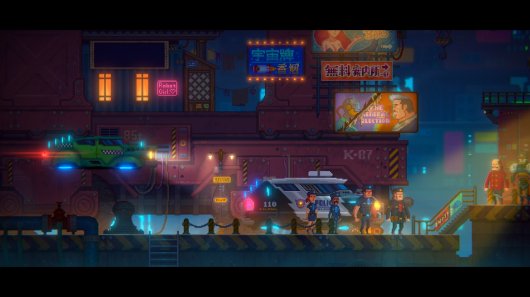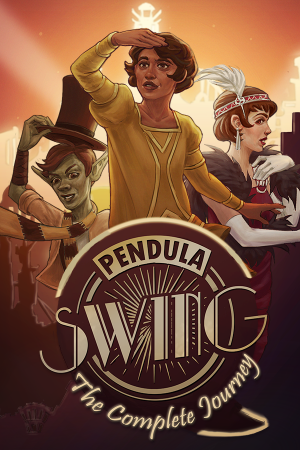Review for Tales of the Neon Sea

Palm Pioneer’s side-scrolling Tales of the Neon Sea originally released in an unfinished state. Consisting of three chapters at the time, the developers vowed to release the fourth and final chapter as free DLC to conclude the story. A year later, that promised installment finally arrived, along with some welcome improvements to the extant content. Unfortunately, even now this is an experience to which the adage “don’t judge a book by its cover” – or in this case, a game by its delightful and vibrant graphics – certainly applies. Although the last chapter definitely picks up the momentum, it’s not worth the tedium and incoherency of everything leading up to it.
Players assume the role of Rex Mist, a film noir-esque alcoholic private detective with a robot arm and leg who lives in a rundown part of a major metropolis in the year 2140. That’s pretty much the book on Rex, as the character is never developed further throughout the game. The story almost has the opposite problem, because it involves so many things that it’s hard to tell what it’s really about until late into the third of four chapters. Throughout his disjointed adventures, Rex encounters a mechanical version of the grim reaper, a dead body lying in the street, an up-and-coming cop who resents him, a weaponized robot conspiracy, a corrupt government official who wants Rex to stop nosing around, a missing person case, a gang war between real and artificial cats, a broken-down servant bot that gains an uncanny level of omniscience, a cold case murder mystery, a mad scientist with a Tesla weapon, human racism against robots, an upcoming election, and probably one or two other things I’m forgetting.
Most of the plot elements are introduced in an almost stream-of-consciousness fashion, never to be mentioned again after their initial appearance. Eventually the story settles down into Rex’s pursuit of a serial killer towards the end of chapter three and through the entirety of the concluding chapter four. While this particular storyline ends more or less satisfactorily, with only a few outstanding questions, most of the other storylines stay missing after they disappear. One plot strand involving a murdered body discovered relatively early in the game, however, makes a surprise reappearance at the very end with the clear intention of leading into a sequel. It’s not exactly a “to be continued,” but it is rather disheartening to finally close the case and then be told you didn’t solve the mystery that got you going in the first place.
While Rex is the main character of Neon Sea, there are a few sequences that switch to William the cat. These sections typically involve navigating the environment via platforming or by crawling through tunnels and vents, disappearing at one entrance to reappear at another. William is apparently an organic cat, as opposed to a robot, but as he solves complex problems, including operating an electromagnet for moving shipping containers, it’s hinted that he’s more than just an ordinary feline, although nothing ever comes of this. The cat angle is an odd inclusion, but no more so than any of the other disparate elements on display here.
Mechanically, this game is a side-scroller operated by either keyboard or controller. I tried both configurations and found that Rex’s movements felt clumsy in each. Moving left and right works okay, although given the large environments that sometimes require backtracking through multiple times, a bit peppier run speed wouldn’t have gone amiss. The more cumbersome aspect comes when moving up and down stairways and ladders. Instead of holding an up or down button to accomplish this, Rex must be positioned in precisely the right place and then an interact button pressed to actually ascend or descend. Lining up Rex in the correct spot, unfortunately, is always a little fiddly. A similar system is used for the occasional platforming challenge, where Rex must be standing in the right place to get the jump prompt to show. These leaps are predetermined actions, and in some places it seems like the protagonist’s jump distance varies. Elsewhere, there are small obstacles in the way that Rex should clearly be able to jump over, but the jump interaction is not offered. These result in having to turn around and go a longer route, which just artificially inflates play time for no particular reason.
Tales of the Neon Sea features a large variety of tasks, from inventory combination, to crime scene investigations, to various logic puzzles, to twitch-based action segments. However, just as the narrative never comes into focus, most of these activities end up being random impediments as opposed to organically arising out of the story. As a result, they tend to be fairly forgettable, tedious, and dull. The bulk of chapter two involves progressing through a chain of characters, each of which refers Rex to another character, but only after having Rex do some protracted errand that is unrelated to anything. As an example, one part of this sequence requires you to retrieve three women who have gone AWOL from the local dance hall. Doing so involves getting security access upgrades to reach different parts of the environment, luring a doctor out of his hospital in order to look up an embarrassing diagnosis on a computer, and setting different lights in a building to a rainbow pattern.
One of the few good things that can be now said about some of the challenges is that they have been cut down in length from the game’s initial release. My first playthrough a year ago required ten hours just to get to the end of chapter three. My latest attempt right from the beginning took only eight. That includes the new fourth chapter and the epilogue, which together are only about an hour long. While I vaguely remembered what to do for some of the earlier puzzles, I don’t believe that familiarity saved a whole three-plus hours of play time.
As the game progresses, it begins to layer extra challenges into its puzzles. Late in chapter two, you will be confronted with an extended power-routing scenario in order to take advantage of the abilities of different machines. The basic concept is straightforward and somewhat interesting, but the machines are spread out over a large geographic area both horizontally and vertically. You will spend significantly more time, even in the newer abridged version, trudging back and forth to form a mental image of the area than actually shunting power and solving the puzzle. In chapter three this type of power-routing makes a reappearance, only this time it’s been weaponized. Robotic drones patrol the area and shoot and instantly kill Rex if they spot him. While your game is restored automatically, instead of being returned to just before the point of death, the entire scenario is restarted from the beginning. It’s worth noting at this juncture that the game does not allow you to freely save. It only provides one progressive autosave that does not record your progress until after the entire segment is completed.
Once that is done, the game goes for something of a change of pace by bringing in a boss battle against a giant robot creature vaguely resembling a spider. Rex must execute a series of gunshots to destroy the robot’s three legs before tackling its eye. When shooting the legs, a small dartboard-like icon with a bullseye appears on-screen and the crosshairs rapidly bounce all around the dartboard. This shooting sequence is somewhat forgiving in that it allows a couple of misses before the robot fires back and kills Rex (again restarting the sequence from the very beginning). Shooting the eye is more difficult, so fortunately here the game does autosave. During this phase a circle pulses in and out of a smaller circle, and failing to hit the eye at the correct point results in instant death. In the initial release, this part was punishingly hard to get through, to the point where I almost abandoned the game. While it still exists in the finished version, it is far more forgiving and shouldn’t prove too much of a challenge for players who at least dabble in the occasional action game.
The inventory-based puzzles of Neon Sea work well enough, at least mechanically. Usually items are picked up by walking near them in the environment and pressing the interact button when the appropriate prompt displays. Attempting to use an object simply requires walking next to a hotspot and interacting again. If an item can be used then the inventory will be displayed, allowing one of the objects to be selected. The inventory never gets very big, perhaps half a dozen items at most. As such it was always easiest just to try every possible item whenever I found a spot that would accept them. Occasionally multiple things can be used together, but these are done at special crafting tables where two different objects can be chosen and then combined if the game allows it.
The reason for resorting to trial and error is due to the description of items you collect. As this is a science fiction game set in the future, it tends to fall prey to far too much technobabble. This applies not only to information about acquired objects (“Pressure measuring unit – A measuring unit that is used to determine pressure, which can turn the skewing pressure of the measuring film into electronic signals”) but also to general descriptions of the next task you need to accomplish (“According to my analysis, I just need to synchronize the resonance frequency of the three small electromagnetic towers and the main electromagnetic tower, move the shooting target away from myself”). While these statements might be meaningful to the characters themselves, they are practically unintelligible to someone like me who doesn’t come from that world. The only recourse: try everything on everything, which doesn’t make for satisfying gameplay.
Given that Tales of the Neon Sea is ostensibly a detective game, it does try to incorporate some investigative elements as well. When a body is discovered, the game switches to a close-up of the corpse (which isn’t ever too gruesome). Rex has two tools for examining the deceased: his normal vision and his UV vision. In normal vision, a focus circle can be moved across the body like a magnifying lens (switching to mouse control for this part if you so desire). The magnifier pulses when something interesting is found. Usually things like blood traces or other injuries can be seen with the naked eye so the lens can be moved to such spots without requiring close scrutiny. However, the UV mode uses the exact same mechanic except that the clues to find only glow visibly when the lens is over top of them, requiring you to painstakingly move it across every inch of the body, essentially performing invisible pixel hunting. As evidence is collected, the individual bits of information are listed on-screen. Once all the items have been found, a prompt appears to combine the evidence into a conclusion. Hitting the appropriate button then does so automatically, with Rex announcing what he’s concluded about his findings. I never felt that I was actually investigating or deducing anything here, simply finding a series of arbitrary hotspots and then combining them when the game told me to.
Pushing this concept further, from time to time the game also features what it calls a deduction board to piece clues together. These clues are simply hotspots found in the normal environment. Once enough have been located, the deduction board can be brought up. The board consists of placing different-sized gears in a pocket watch, with each gear representing a particular clue. The gears must be placed so that they connect the stem of the watch to its center in one continuous chain. Highlighting a gear gives a description of the clue it represents, and I suppose the watch could be pieced together by actually deducing the clues. However, this is a very common puzzle and since there’s only a limited number of ways the gears can be arranged, again it was just easier to ignore the clues and fit the clock pieces in directly. For obvious reasons, this feels more like watch building than mystery solving. Fortunately, in the added fourth chapter, where many recreations of crime scenes exist, the developers wisely decided to ditch this mechanic entirely.
Audio-wise the game is acceptable for the most part. The light noir jazz instrumentals generally just fade into the background, never annoying but never really distinguishing themselves either. Sound effects typically fit the circumstances, and things like gurgling coffee pots or wall clocks get louder the closer Rex gets to them and softer again as he moves away.
All dialog is presented in text at the bottom of the screen, with words slowly being revealed one letter at a time. Thankfully the interact key can be pressed to display the entire line all at once, but it would have been nice to have a general game option that skipped the ticker-style scroll and just showed the full lines automatically. The game is completely unvoiced, which is perhaps for the best as the localization ranges from mediocre to downright poor. There are even a few instances where untranslated lines are still present, although only on incorrect actions as opposed to things that must be done to complete the game.
The one area where Tales of the Neon Sea does shine is its graphics, using a pleasing pixel art style that often mixes dark settings with bright and colourful light – hence the “neon” in its title. The varied light sources even suitably affect any characters who wander close to one. The locales tend to be fairly generic industrial spaces, although they are usually embellished with vivid signs or even the occasional tree or sculpture. Even so, the differences between a sort of futuristic Chinatown, a decrepit freighter, the sewers, and even Rex’s apartment are surprisingly minimal. They’re pleasing enough to look at, but the relative sameness means that none of them are particularly memorable. This changes to a degree in the fourth act, in which Rex is subjected to induced hallucinations. Here he revisits crime scenes from his past and other esoteric places, including a theatre filled with creepy clown masks and a giant robot goddess standing in a river of light.
Most places in the city have a lot of background characters wandering around, which provide a nice animated texture to the settings and are kind of fun to watch in their own right as they mill about. Even when standing still, the various characters incorporate cute little bouncy movements, and they all have a surprising amount of detail given how few pixels they consist of. Whether a robot servant that looks like WALL-E, a muscle-bound cop that has only just started to let himself go, or a mad scientist with purple hair and a clown nose, they all exude a distinctive visual personality.
When Tales of the Neon Sea first released, I wished I could have my time back even before reaching its non-ending. While great strides have been made in shortening the more egregiously tedious activities and simplifying the most punishingly difficult sections, overall the first three chapters of play are still not a positive experience. The story never goes anywhere, the characters never develop in any meaningful way, and the puzzles generally feel like padding disconnected from the events going on. That changes with the more recently added final chapter four, where the plot becomes much more focused on a central pursuit and most of the puzzles and gameplay emerge far more intuitively from it. However, slogging through seven hours of drudgery for one hour of OK-ness isn’t going to be most people’s cup of tea. There are far better science fiction and/or noir-inspired detective adventures out there than this one.
Our Verdict:
A positive late-game change in design ethos and cute atmospheric graphics can’t save Tales of the Neon Sea from a lack of story coherency, tedious gameplay, and poor writing.



















__small.jpg)









